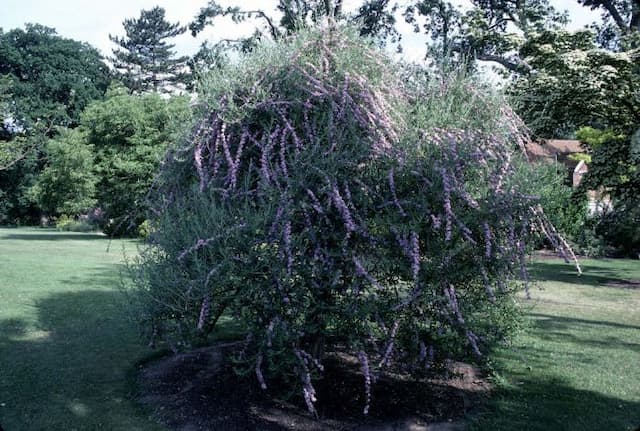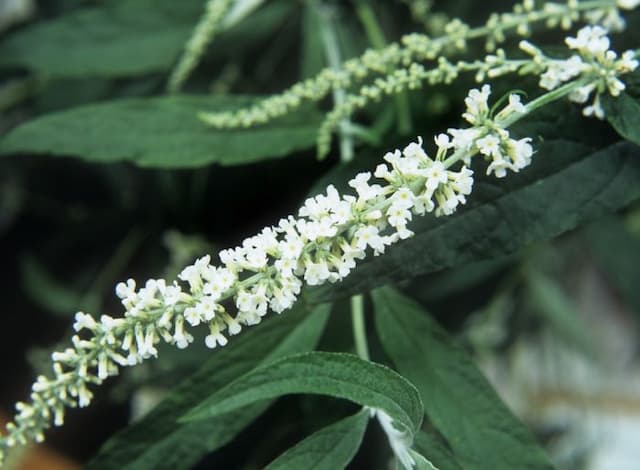Butterfly Bush Buddleja davidii Buzz Sky Blue = 'Tobudskybl' (PBR) (Buzz Series)
ABOUT
The Buddleja davidii Buzz Sky Blue, also known as the Butterfly Bush, is an ornamental plant known for its attractive and prolific flowers. It showcases pointed lance-shaped leaves that are a soft grey-green color, providing a lush backdrop for the vibrant blooms. The most striking feature of this cultivar is its conical clusters of tiny, tubular flowers that come in a shade of sky blue. These flowers are rich in nectar, and their sweet fragrance often attracts an array of pollinators, including butterflies and bees. Due to its compact growth habit, the Buzz Sky Blue variant is popular among gardeners with limited space and those who wish to add a splash of color to their outdoor spaces without committing to a large, sprawling plant.
About this plant
 Names
NamesFamily
Buddlejaceae.
Synonyms
Butterfly Bush, Summer Lilac, Blue Spirea, Nanho Blue, Buzz Sky Blue.
Common names
Buddleja davidii 'Tobudskybl'.
 Toxicity
ToxicityTo humans
The Butterfly Bush (Buddleja davidii) is not generally considered highly toxic to humans. There are no severe symptoms associated with the ingestion of this plant, and it is mainly considered non-toxic. As with any plant, individual sensitivities can vary, and ingesting plant parts might cause mild stomach upset in some people, but there are no widespread reports of serious poisoning or extreme health consequences from the Butterfly Bush.
To pets
The Butterfly Bush (Buddleja davidii) is also not known to be highly toxic to pets. This plant is generally considered to have a low risk of poisoning for domestic animals such as dogs and cats. Ingestion of this plant might cause mild gastrointestinal symptoms such as vomiting or diarrhea in some sensitive pets, but serious toxicity is not expected. Owners should always monitor their pets and prevent them from eating large quantities of any non-food plants, including the Butterfly Bush, as precautionary measures.
 Characteristics
CharacteristicsLife cycle
Perennials
Foliage type
Deciduous
Color of leaves
Green
Flower color
Sky blue
Height
3-4 feet (0.9-1.2 meters)
Spread
2-3 feet (0.6-0.9 meters)
Plant type
Shrub
Hardiness zones
5-9
Native area
China
Benefits
 General Benefits
General Benefits- Compact Size - Ideal for small gardens or patios due to its dwarf nature.
- Long Blooming Period - Produces flowers for an extended period, generally from early summer to the first frost.
- Attracts Pollinators - Acts as a magnet for butterflies and bees, supporting local ecosystems.
- Low Maintenance - Requires minimal care once established, making it suitable for busy gardeners.
- Drought Tolerant - Once established, it has good resistance to drought conditions.
- Fast Growing - Reaches maturity quickly, providing a full and colorful display relatively soon after planting.
- Colorful Foliage - In addition to flowers, it has attractive foliage that adds interest even when not in bloom.
- Deer Resistant - Less appealing to deer, which can be beneficial in areas where deer browsing is a problem.
- Container Friendly - Can be grown in containers, offering flexibility in garden design and space utilization.
 Medical Properties
Medical PropertiesThis plant is not used for medical purposes
 Air-purifying Qualities
Air-purifying QualitiesThis plant is not specifically known for air purifying qualities.
 Other Uses
Other Uses- Photography Prop: Buddleja, or Butterfly Bush, can be used in photography to attract butterflies and create a lively, natural backdrop for garden and nature scenes.
- Art Inspiration: The vibrant blue-purple flowers of the Butterfly Bush serve as a striking subject for artists, providing inspiration for paintings, drawings, and textile designs.
- Teaching Tool: Educators can use Butterfly Bush in lessons about pollination, entomology, and plant biology due to its attractiveness to butterflies and bees.
- Erosion Control: With its robust rooting system, a Butterfly Bush can be planted on slopes or areas prone to erosion to help stabilize the soil.
- Privacy Screen: Due to its fast growth and dense foliage, Butterfly Bush can be used to create a quick-growing natural screen for privacy in the garden.
- Theme Gardens: Butterfly Bush is an ideal choice for “moon gardens” designed to be enjoyed at twilight, as its blooms may still attract pollinators like moths.
- Color Accent in Landscaping: The unique sky blue color of 'Buzz Sky Blue' provides a cool color accent in garden designs, contrasting well with warmer colors.
- Floristry: Fresh or dried, Butterfly Bush flowers can be used in floral arrangements for their texture and color.
- Ecological Studies: Butterfly Bush can be utilized for studying invasive plant species' impact on local ecosystems, as it is known to spread readily.
- Potpourri: Dried Butterfly Bush flowers can be included in potpourri mixes for a light, pleasant fragrance and pop of color in home décor.
Interesting Facts
 Feng Shui
Feng ShuiButterfly bush is not used in Feng Shui practice.
 Zodiac Sign Compitability
Zodiac Sign CompitabilityButterfly bush is not used in astrology practice.
 Plant Symbolism
Plant Symbolism- Transformation and Change: Buddleja, commonly known as Butterfly Bush, often symbolizes change and transformation owing to its ability to attract butterflies, which are creatures noted for their life cycles of metamorphosis.
- New Beginnings: The Butterfly Bush's continuous blooming cycle represents new beginnings and fresh starts, making it an ideal symbol for those embarking on a new phase in their lives.
- Attraction and Magnetism: With its bright, fragrant flowers that draw in butterflies and bees, Butterfly Bush is often associated with attraction and the ability to draw positive things into one's life.
- Inspiration: The sight of butterflies flitting from bloom to bloom on a Butterfly Bush can symbolize creativity and the inspiration needed to create beauty in one's surroundings.
- Rebirth and Resilience: As a plant that revives and blooms profusely each year, Butterfly Bush is a symbol of rebirth and the resilience needed to overcome obstacles.
 Water
WaterThe Butterfly Bush (Buddleja davidii) should be watered thoroughly, allowing the top inch of soil to dry out between waterings. During the growing season, this may mean watering once a week, but always check the soil moisture level first. It is important to avoid overwatering, as this can lead to root rot. On average, a Butterfly Bush may require around 1 to 1.5 gallons of water each week, but this can vary based on climate conditions and the maturity of the plant. During hot, dry spells, additional water may be necessary.
 Light
LightThe Butterfly Bush prefers full sun conditions to thrive, meaning at least 6 to 8 hours of direct sunlight daily. An ideal spot would be an open area that receives unfiltered sunlight throughout the day. If you are planting it in a garden, make sure it's an area without tall trees or buildings casting shadows on the bush for the majority part of the day.
 Temperature
TemperatureThe Butterfly Bush is hardy and can tolerate a range of temperatures; however, it grows best when the temperature is between 60°F and 90°F. It can survive temperatures down to 20°F but may suffer damage if the temperature drops below this point. Its upper temperature tolerance extends to around 100°F, above which the plant may require additional care like shading or increased watering.
 Pruning
PruningPruning encourages healthy growth and abundant flowering in the Butterfly Bush. It should be pruned in the late winter or early spring before new growth begins. At this time, you can cut back the entire shrub to about 12 inches above ground level. Pruning is typically done annually, as the Butterfly Bush blooms on new wood.
 Cleaning
CleaningAs needed
 Soil
SoilButterfly Bush thrives best in well-draining soil with a slightly acidic to neutral pH between 6.0 and 7.0. A good mix would include loamy garden soil, compost, and coarse sand to improve drainage. Mulching is beneficial to retain moisture and suppress weeds.
 Repotting
RepottingButterfly Bushes in the Buzz Series are relatively compact and may not need frequent repotting. It's generally suggested to repot these shrubs every 2-3 years or when the plant has outgrown its current container.
 Humidity & Misting
Humidity & MistingButterfly Bush is adaptable to a wide range of humidity levels and does not require specific humidity conditions to thrive. It's comfortably grown in the ambient outdoor humidity.
 Suitable locations
Suitable locationsIndoor
Place in direct sunlight, ensure good airflow.
Outdoor
Full sun, well-draining soil.
Hardiness zone
5-9 USDA
 Life cycle
Life cycleThe Butterfly Bush (Buddleja davidii Buzz Sky Blue) begins its life cycle as a seed, which, once sown, germinates in warm conditions with adequate moisture. Emerging seedlings grow into young plants, developing a root system and foliage. As the plant matures, it enters the vegetative stage where it focuses on leaf growth and establishing a robust framework. Upon reaching maturity, typically within a year, it enters the flowering stage during summer, producing clusters of sky-blue flowers that attract pollinators such as butterflies and bees. After pollination, the flowers develop into seed capsules, which eventually open to disperse seeds, completing the reproductive cycle. The plant then enters a period of dormancy during the winter, reducing metabolic activities to survive the cold, and will rejuvenate with new growth in the following spring.
 Propogation
PropogationPropogation time
Spring to Summer
Propogation: The most popular method of propagating Buddleja davidii, more commonly known as the Butterfly Bush, is through semi-hardwood cuttings. This is best done in late summer. A cutting of about 4 to 6 inches (10 to 15 centimeters) is taken from a healthy, non-flowering stem. The leaves on the lower half are removed, and the cut end is often dipped in a rooting hormone to increase the success rate. The cutting is then planted in a mixture of perlite and peat or a similar well-draining medium. It's kept under high humidity and indirect light until roots develop, which typically takes a few weeks to a couple of months. After rooting, the new Butterfly Bush plant can be transferred to a larger pot or directly into the garden.
![Butterfly bush [Buzz Magenta]](/_next/image?url=https%3A%2F%2Fplants-admin.emdemapps.com%2Fimages%2Fplants%2F%2Fimages%2F604b58e34126b.png&w=640&q=75)
![Butterfly bush [Peacock]](/_next/image?url=https%3A%2F%2Fplants-admin.emdemapps.com%2Fimages%2Fplants%2F%2Fimages%2F604b634800554.png&w=640&q=75)





![Butterfly bush [Florence]](/_next/image?url=https%3A%2F%2Fplants-admin.emdemapps.com%2Fimages%2Fplants%2F%2Fimages%2F604b5f52d7bb1.png&w=640&q=75)
![Butterfly bush [Marbled White]](/_next/image?url=https%3A%2F%2Fplants-admin.emdemapps.com%2Fimages%2Fplants%2F%2Fimages%2F604b63353832a.png&w=640&q=75)
![Butterfly bush [Nanho Blue]](/_next/image?url=https%3A%2F%2Fplants-admin.emdemapps.com%2Fimages%2Fplants%2F%2Fimages%2F604b55d0a6d2d.png&w=640&q=75)